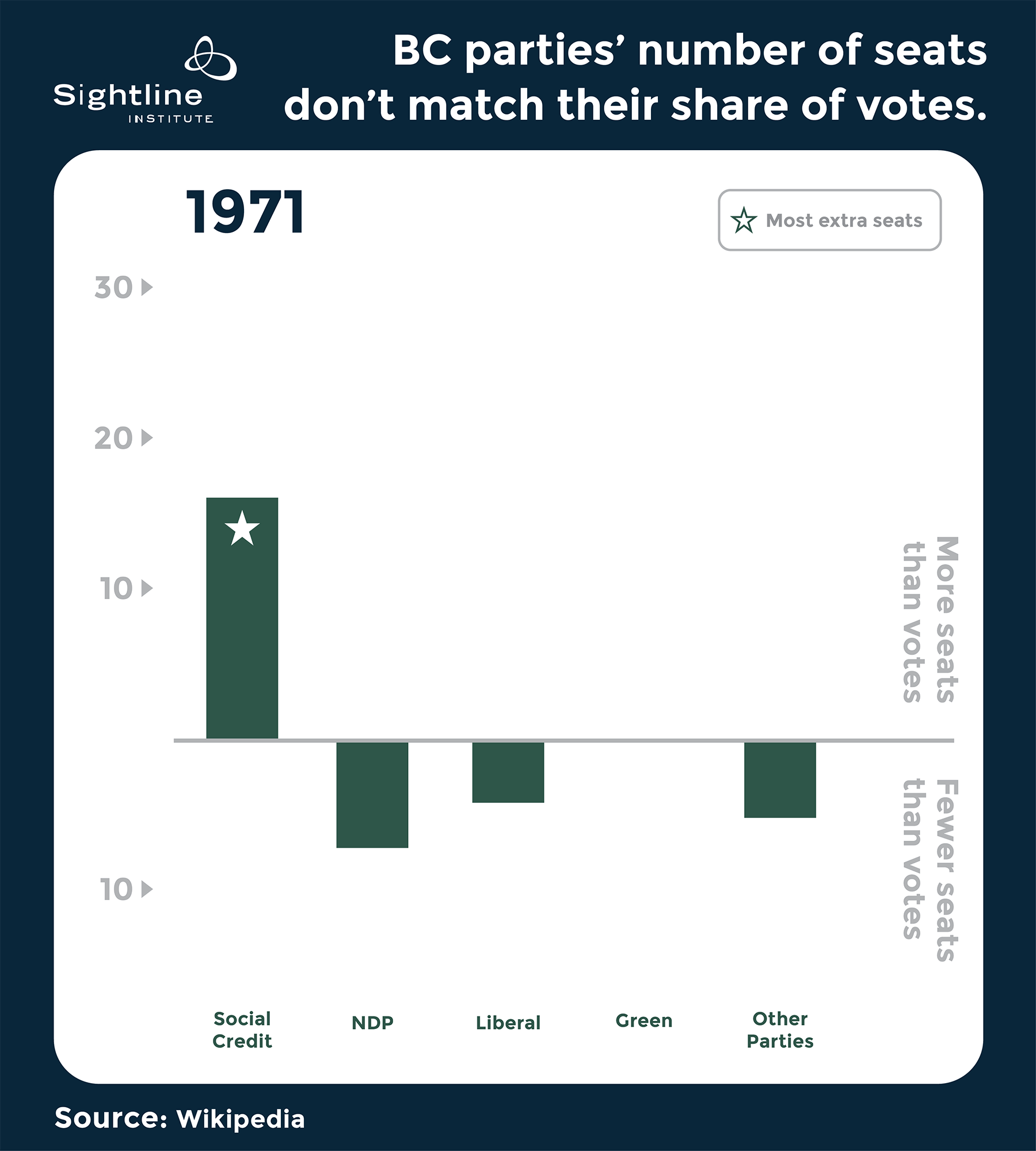In northern Cascadia, BC voters will soon vote on a referendum to use Proportional Representation to help ensure Members of the Legislative Assembly (MLAs) better reflect the will of the voters. BC’s current electoral method—single-winner ridings with first-past-the-post ballots—has been distorting the will of the voters for decades. BC’s election history highlights the well-known flaws of archaic first-past-the-post voting. In the past five decades, BC elections often put power in the hands of a party the voters didn’t want, and elections always give extra seats to a party that didn’t earn enough votes to warrant those seats.
Most BC elections since the 1990s have produced perverse results
British Columbia (and almost all Canadian provinces and American states) use an outdated electoral method that is sometimes called a “majoritarian” method that is known to allow two parties to dominate elections, even when voters prefer other parties. Proponents argue that while majoritarian systems fall short in full representation, they make up for it by ensuring a party with majority support will win control of the government. But even this supposed saving grace of archaic majoritarian systems is often not true, and certainly has not been the case in British Columbia.
BC’s current electoral method—single-winner ridings with first-past-the-post ballots—has been distorting the will of the voters for decades.
In BC, the ruling party or coalition has only won a majority of the popular vote in 2 of the past 12 elections! In 2017, the NDP and Greens jointly won 57 percent of the votes and control of the government. In 2001 the Liberals won 58 percent of the vote and control. In the other 10 elections, one party won control of the government with only a minority of the votes.
In five of the past seven elections in BC, not only did the ruling party win less than a majority of the popular vote, the ideological side that controlled the government was less popular with voters than the side that lost. Voters went progressive, but the government went conservative, or vice versa. Can we even call it representative democracy when the government leans in the opposite direction from what people voted for?
In 2013, 2009, and 2005, the conservative Liberal Party (sorry Americans, I know that is confusing, but the BC Liberals are the center-right party) won control of government, while the left-leaning New Democratic Party (NDP) and Green Party together won more votes. In 1999 and 1991 the pattern was reversed, with the more progressive NDP winning control of the government even though a majority of voters chose the right-leaning Liberals.
The graph below shows five of the past seven elections in BC (every one other than 2001 and 2017). The bars show the percentage of votes the Liberal Party or NDP Party or NDP plus Green Party won. The star indicates the party that controlled the government. As you can see, in these five elections, the controlling party’s votes fall short of a majority. In four elections the opposing party or coalition won a majority of the votes. BC government is often controlled by a party the voters didn’t pick.

Original Sightline Institute graphic, available under our free use policy.
All BC elections give one party extra seats at the expense of other parties
BC’s single-winner, first-past-the-post voting systematically advantages one large party in each election at the expense of others. The particular party that benefits has changed over time—throughout the 1970s and 1980s it was the Social Credit Party, in the early 1990s it was the NDP, and throughout the 2000s it has been the Liberal Party. But the dynamic is always the same—voters turn in their ballots, but single-winner ridings and first-past-the-post counting translate their votes into one party getting more seats than the votes warranted.
In the 1970s and 1980s, the right-wing Social Credit Party benefited from this dynamic, winning an additional 4 to 16 seats each year. These unearned seats helped the party win decisive control of the government—occupying 54 to 69 percent of seats—while winning less than a majority of votes. In those years though, the Social Credit Party and the right-leaning Liberal Party together won a majority of the votes, so at least the government was pointed in the same direction as the voters.
The early 1990s saw a shift, and the NDP won the seat advantage for two elections. Throughout the 2000s, the NDP and Greens have split the left-leaning vote, allowing the Liberals to win the seat advantage. In 2001, the Liberals won a whopping 31 unwarranted seats. In a legislature of 79, the Liberals won 39 percent more seats than they deserved based on votes. In other years, the Liberals won an additional unearned 8 to 11 seats per year, earning decisive control of the legislature—around 58 percent of the seats—despite winning only around 45 percent of the popular vote.
In recent decades, voters for the Green Party have been the big losers, being denied 6 to 12 seats that voter support should have won in each election.
In the gif below, the bars show the difference between the number of seats each party should have won based on their share of the popular vote and the number of seats they actually won due to first-past-the-post voting. Bars above the line mean the party won more seats than they had votes to justify, and bards below the line mean the party won fewer seats than they had votes. The star indicates the party that won control of the government.

Original Sightline Institute graphic, available under our free use policy.
Liberals view PR as existential threat based on recent history, but they could take longer view
Single-winner ridings and first-past-the-post voting means parties don’t have to win the hearts and minds of most BC voters to win control of the BC government. In the past two decades, the Liberal Party has benefited from this dynamic at the expense of the Green Party. But looking a a few decades further back, the Social Credit Party benefited at the expense of the Liberal Party.
The tides could change again in the future. If BC voters choose to move to Proportional Representation, voters’ preferences will determine which party or coalition takes control. If voters lean left, the NDP and Greens will be in charge; if voters lean right, the Liberals will take the reigns. Parties will be rewarded for winning over voters, not for the luck of benefiting from a distorted system.












Lee Mortimer
A lot of attention has been given to the fact that a referendum on proportional representation will be held this fall. But there is no clear indication of what kind of PR. The likely possibilities are the single-transferable vote and mixed-member proportional representation. How about a look into which PR method voters are likely to see on the ballot.
Kristin Eberhard
We recently updated our glossary of electoral methods to include three “made-in-Canada” PR methods that might appear on the ballot. But we won’t know until we see it! http://www.sightline.org/2017/05/18/glossary-of-methods-for-electing-legislative-bodies/#proportional-methods
Lee Mortimer
A great and informative glossary! Inquiring of the parties which method they might be leaning toward would also make an interesting article.
Ann Remnant
We are expecting the government to come out with legislation in the next couple of weeks regarding the referendum question. The consultation period with BC voters ended on Feb 28. With a bit of luck, it is being used to help shape the question and system(s) proposed.
Richard Lung
I’m sorry but this article is a typical piece of party monomania. Voting is for voters, not parties. Proportional representation is usually assumed to be between parties, but it actually means equitably elected representatives. The BC Citizens Assembly recommended genuine proportional election of representatives by the voters, with a system of voters lists called Single Transferable Vote.
The BC parties each, in their own ways, put in a decisive block on STV. Those parties favoring so-called PR favor party lists (not voters lists).
The Mixed Member Proportional system combines party list elections with the existing system of plurality or simple majority counting. This gives the voters two illiterate x-votes, one for a single district and one for a party list. What this generosity amounts to is that candidates get two chances of election by dual candidature. MMP is a doubly safe seat joke election, or fools paradise for career politicians.
Labour mostly successfully dumped AMS (alias MMP) on British voters, gathering some passionate support from obtuse pressure groups. Canada follows suit. In Britain there is some movement to replace AMS with STV, still of uncertain out-come. But a real possibility, I would guess. Richard Lung. Democracy Science.
John
I think the PR system is dead in the water in BC. Even knowledgeable political people can not explain the system(s) due to a lack of education and promotion on the issue. It is April now and the referendum is in the fall. During the summer not much is done politically. The only change I can see being understood and acceptable to the electorate would be to institute a ranked ballot. This should not find much resistance from any of the political parties as this is the system they use at there conventions. The liberal leader would now be Dianne Watts with FPTP but with ranked balloting the liberals elected Andrew Wilkinson. PR is not understood and will not be supported.
Ian MacKenzie
Except for political aficionados I don’t believe the average voter understands, or would accept if they did understand, the ins and outs of first-past-the-post with its lack of proportionality, its seizure of power with less than 50%, its vulnerability to computer manipulation, its dependence upon swing ridings which could be won by a single vote, its so-called “democracy” when 60% of votes are thrown away with 60% of voters being unrepresented, its hiding of “fringe” elements within the membership of the two larger parties, its need for tactical voting so often seen where voters don’t vote for the party they want but against the party they dislike the most, the cost and instability of alternating parties with opposing philosophies, etc..
Such an apparently “simple system”, because of these deficiencies in achieving any resemblance to democracy, may APPEAR simple, but is not simple at all. It is extremely complicated with the teeter-totter always weighted to elitism leaving the slightly knowledgeable voter trying to balance all these defects against what they think a single ideology may provide. Unfortunately, for the past 16 years, we have given such an ideology free rein to do what it pleases and to ignore the wishes of the majority of voters through a false majority in most elections.
We need to change from this old fashioned and unfair system so that every vote counts. This is called Proportional Representation (PR). But this term is an umbrella term because it describes, in each case, a different form most uniquely suited to the country, province, or municipality it is practiced in. However, every form has the same fundamental principle, to maximize the power of every vote cast. In other words to get as close to true democracy as possible. Because of the variety of forms PR may SEEM complicated but it is fundamentally the simplest of all electoral systems because it suffers from none of the problems listed in the previous two paragraphs.
Vote for proportional representation and do yourself and your children a big favour.
harriet
richard lung and John don’t know what they’re talking about. Do they know how a tree grows? Do they know how their cars work? Can they repair the innards of their computers? We don’t have to understand the exact details of a PR system.
what everyone can understand is this. Our current voting system is completely unfair and undemocratic. Thirty-nine per cent of the popular vote in the last federal election (do you two know what the popular vote is? I’m not being nasty just asking.) got 100 per cent of the power to govern.
Proportional representation is not difficult to understand but there are many systems. Most PR systems are adapted to the geography of the country. Our PR system can be honed by Elections BC and Citizens Assembly. Please go to Fairvote canada and read about Local PR, and Urban Rural PR. Also read Fair Vote’s submission to the (long past questionnaire by our government) We can have a proportional system made for BC where there WILL be local representation and rural less populous areas will NOT be left out.
Eighty per cent of Western countries use proportional systems. They all work much better than ours. Government has to cooperate, be civil and govern by consensus. Laws made are what most people want and can accept and thus are more stable. They don’t have the policy lurch we have going from NDP to Liberal and back with one party undoing what the other has done. This is only one advantage of PR.
Only the Big Boys in the NDP and the Liberals want to nix PR because they want to keep their power. The single transferable vote is eminently elegant. I could explain it to you in a moment with Lego Blocks. But we can have an even better Made For BC proportional system. Please study a bit more.
harriet
Gregory Lang
The title of this article includes “the will of the people”, yet the body of the text speaks only to the people who exercised their freedom to cast a ballot and ignores the electors who freely chose to not vote.
The logical and non-presumptive interpretation of the non-voter is that they view all outcomes as equal; an abstention. In that it is a virtual certainty that one candidate will win; their equality in outcomes reflects support, and only support. Game and Choice theory models support this singular conclusion.
The will of the people in BC has therefore in fact been quite well represented in Government. In 2017 every single community of electors (voters and non-voters) returned to the Legislature a representative who enjoyed more than 50% support from their community of electors.
The people of BC lose when they vote for Party and or Leader instead of for the best person to represent their community. We use our private voice to vote; but we vote for a collective choice to represent us and our neighbours.
If more than 95% of the people do not belong to a political party, why would they want to give those clubs more power in democracy?
PR only changes how many oligarchy clubs get into the Legislature; from fewer – because it requires a lot of work, to more because we count votes across communities that have nothing to do with each other.
G. Steemson
Gregory Lang, your observation that an abstaining voter can reasonably be assumed to view all of the available options as functionally equivalent is as good a rule of thumb as any I have seen — but your assertion that it should therefore be counted as approval of whichever candidate actually won is completely arbitrary. In the majority of elections I have experienced, no candidate with a reasonable chance of winning was one I would willingly vote for if there were a plausible alternative.
In support of open and less-biased discourse, I’ll admit that I personally do try to vote whenever I am eligible to. Unfortunately, most of the time the candidates are so underwhelming that it comes down to voting for whichever of the front-runners appears likely to do the least amount of damage; therefore, I often bother to cast a ballot mostly on the basis that after having done so I can whinge about the results with a clearer conscience. Extrapolating my own experiences to the enfranchised population at large would indicate that few if any candidates ever get elected with even so much as a strong minority of popular support.
Does any of this really seem like a dependable basis for healthy and stable governance? I certainly can’t consider it so. Close to any change that gets put into place would represent at least _some_ improvement; of course, as other posts in this thread have pointed out, that hasn’t stopped those currently in power from finding obscure ways they could quietly make it worse instead. All the public can do is keep an eye on the process and raise a stink if it looks like the proposal has been sabotaged, most likely by careful weasel words in the text of whatever bill gets put up for a vote.